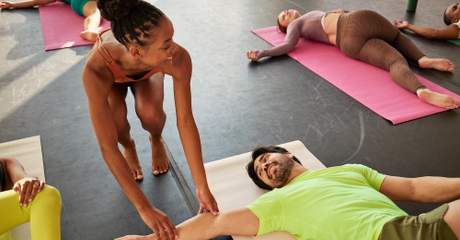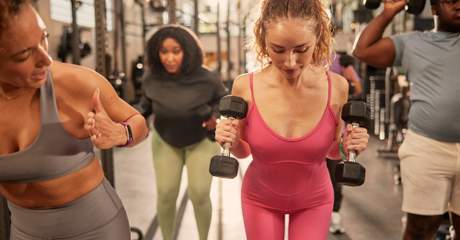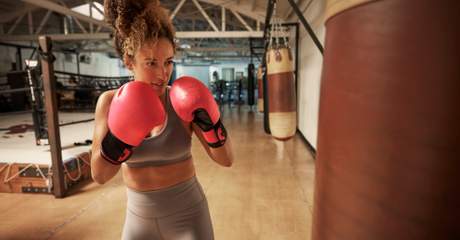Maximize Your Gym's Potential: Leveraging the Five Components of Fitness for Success
Last Updated Jan 28, 2025

As a gym owner, you know all about what it takes to get physically fit. It’s your passion, and you’re spending your days helping others achieve that too.
But passion isn’t the only ingredient for success in the fitness business. It’s a competitive field — there are 112,496 gyms, with the amount increasing every year. And that’s before you account for at-home workouts, which is where about about half of Americans exercise.
So how can your gym stand out?
One strategy to consider is offering fitness classes that cover each of the five components of fitness. Helping your clients become holistically fit can be a great path to growth!
What Are the Five Components of Physical Fitness?
Developing a firm understanding of these foundational elements of fitness is the first step in crafting a gym that supports them all
- Cardiovascular endurance. This is the ability of your heart and lungs to supply oxygen to your body during a sustained period of exertion.
- Muscular strength. This is the ability of your muscles to lift weight or exert force. The more weight your muscles can take, the stronger they are.
- Muscular endurance. Your muscles might be strong, but how long can they hold that tension? That’s what muscular endurance is: how long your muscles can sustain an exercise.
- Flexibility. Flexibility allows your muscles to move in a full range of motion without pain or difficulty, and improves your balance.
- Body composition. Your composition is the ratio in your body of fat mass to fat-free mass, like muscle or bone. While you need body fat, it’s important to have a healthy balance between the two types of mass. A more physically fit composition has a higher concentration of non-fat.
Core Component 1: Cardiovascular Endurance
Cardiovascular endurance requires strong heart health. To get that high level of endurance, you know your patrons need regular aerobic exercise. Your gym can provide aerobic classes and expert-led training. These offerings can be the heart of your gym, helping provide unique value to your customers.
So what could that look like? Incorporating heart health into your gym requires offering a variety of endurance-based classes that can be performed at a variety of endurance levels. Classes you can consider include::
- Spin classes. Hitting that stationary bike is a great way to get the heart pumping. It’s always more fun to pedal in place for an hour when there’s someone leading the workout, and you cycle to fun music.
- Power yoga. Yoga can improve artery relaxation, which in turn lowers blood pressure. Power yoga is a more intense version of yoga that also works as a form of cardio because it gets the heart pumping. This exercise involves intense movements at a high speed, which should push your body.
- Walking clubs. Walking clubs can be great programming for entry-level gym members. These groups can help people get their steps in and make connections with each other. As a bonus for your member retention, providing ways for your clients to exercise together can improve exercise consistency.
- Kickboxing. Kickboxing is a fun way to build up endurance and get moving. It’s a form of boxing that strengthens and tones muscles.
Core Component 2: Muscular Strength
Strength is another important component of fitness that your gym can help people develop. Often, the workouts that help people develop strength require bulky and expensive equipment. That makes this component of fitness a way for your studio to compete with at-home exercises. Your gym can provide those muscle-building tools people don’t have room to store, especially as many people want good variety in the machines they use.
Here are a few key machines to consider adding to your set-up:
- Treadmills. A treadmill might feel basic, but it’s a way to get moving. In addition to working cardio, running on a treadmill can help tone your muscles.
- Elliptical machines. Ellipticals help push your leg muscles. Plus it is a versatile piece of equipment with many exercise options.
- Ergs. Also known as rowing machines, these allow people to get a full-body workout by pushing a moveable seat with their legs and then pulling a handle toward their chest with their upper body. This can be a great way for gyms to offer a comprehensive strength-building exercise.
- Strength training machines. Those three tools are just the start. You could consider having a weight machine that helps you build your arms. A chest press, as well, can add versatility to your workouts. These can help you work your pectoral muscles. With all of these tools together, you can truly improve your strength.
Core Component 3: Muscular Endurance
Your customers can build muscles, but they also need to be able to sustain that exercise for long periods of time to hit their goals. Here are a few tips to set your gym to provide tools for endurance::
- Program your classes to build. To help your clients build endurance, they need to hit progressive overload. That means each workout needs to get harder gradually. Consider programming your classes to progressively build.
- Create running clubs. Running develops endurance. To get people running, consider a track club. A group workout can create a fun environment to build stamina. Club participants can use the treadmills or the track together.
- Try a challenge or competition. Healthy competition can motivate people. In fact, people in competitive groups attended 90% more classes than other patrons. Consider setting up some kind challenge. For example, you might have a cycling class try to hit a new record time.
Core Component 4: Flexibility
Flexibility is having healthy movement in your joints. In your gym, that might include encouraging stretching. Here are a few ideas to get started:
- Add flexibility classes to your roster. A great way to help is to add stretching to the rotation of classes. Yoga and Pilates classes are a great way to do this.
- Offer stretching machines. Stretching machines are a great way to give people access to stretching opportunities. They can work on their joint flexibility during their workouts.
Encourage stretching in all other workouts. Consider adding stretching into other workout classes. Having participants warm up or cool down alongside other workouts lets you pair mobility with other core components of fitness..
Core Component 5: Body Composition
Most people want to build muscle and burn fat. It’s hard to measure your body fat percentage on your own, though. Your gym can provide the tools to make that simple. That way your patrons have information beyond their BMI. Here are a few ideas to get you started offering body composition tools:
- Provide body composition scales. These specialized scales can measure body fat, muscle mass, protein mass, and metabolic rates. You can add these to your gym to help your patrons see their muscle building progress. .
- Encourage regular check-ins. Consider encouraging your patrons to regularly check in with the scales. You could put up signs that advertise where they’re located. When patrons look at their body composition, they can see how their workouts are benefiting them. That can be encouraging if they aren’t losing weight.
- Hold educational sessions on body composition. You could also consider holding regular classes about body composition. These courses can show how important it is to understand your fat and muscle ratio. Doing so empowers your patrons to actively improve their health. Classes also show them that you’re a fitness expert.
How to Leverage the Five Components of Fitness in Your Gym
Leveraging these components helps you provide what your patrons need. It also showcases that you and your team are experts. Here are a few ways you can leverage these five components in your gym for long-term success:
- Provide diet education. One half of the fitness equation is diet. To increase long-term health, consider offering diet planning courses. These can help you show how important holistic wellness is, encouraging patrons to utilize all your resources.
- Supply workout plans. You could offer your customers general exercise itineraries that make full use of all five aspects. This can help you encourage people to use all provided machines.
- Create five component classes. All five aspects of fitness matter, so incorporate all of them into one course. For example, it could involve stretching, running, and strength building.
Customizing Your Clients’ Fitness Experience
Harnessing the power of offering a holistic view of physical fitness is only one way to help boost your offerings.
Another way is to partner with Wellhub. Wellhub offers companies a way to provide their employees with access to exercise studios in their area as a wellness benefit. Being one of those gyms means you can access a steady stream of new patrons into your facility.
If you’re looking for more ways to gather more patrons, partner with Wellhub!

References
- CDC. (n.d.). 3 Reasons to Work Out With a Friend. Retrieved November 17, 2023 from https://www.cdc.gov/diabetes/library/spotlights/workout-buddy.html.
- CDC. (n.d.). Body Mass Index: Considerations for Practitioners. Retrieved January 30, 2024 from https://www.cdc.gov/obesity/downloads/bmiforpactitioners.pdf.
- Davidson, K. (2022, May 23). What Are the 5 Health-Related Components of Physical Fitness? Healthline. Retrieved January 30, 2024 from https://www.healthline.com/health/fitness/health-related-components-of-fitness#flexibility.
- Glick, M. (2021, December 7). WHAT DO PEOPLE WANT IN A GYM? Retrieved January 30, 2024 from https://www.styku.com/blog/what-do-people-want-in-a-gym.
- Goodwin, E. (2023, June 21). More Americans Work Out at Home Than in Gyms, Citing Convenience. Retrieved January 30, 2024 from https://civicscience.com/more-americans-work-out-at-home-than-in-gyms-citing-convenience/
- IBIS World (2023, November 10). Gym, Health & Fitness Clubs in the US - Number of Businesses. Retrieved January 30, 2024 from https://www.ibisworld.com/industry-statistics/number-of-businesses/gym-health-fitness-clubs-united-states/
- InBody. (n.d.). WHAT IS BODY COMPOSITION? Retrieved January 30, 2024 from https://inbodyusa.com/general/what-is-body-composition/
- Lifespan. (2022, May 23). What Does Running on a Treadmill Do to Your Body? Retrieved January 30, 2024 from https://www.lifespanfitness.com.au/blogs/fitness-blogs/what-does-running-on-a-treadmill-do-to-your-body
- Marsden. (2022, June 23). Understanding your body composition scale measurements. Retrieved January 30, 2024 from https://www.marsden-weighing.co.uk/blog/body-composition-scale-measurements
- Oaklander, M. (2016, November 1). Science Says This Is the Best Motivation to Exercise. Time. Retrieved January 30, 2024 from https://time.com/4553305/workout-competition-exercise-motivation/.
- Penn Medicine. (2016, March 17). How Yoga Benefits the Heart. Retrieved January 30, 2024 from https://www.pennmedicine.org/updates/blogs/heart-and-vascular-blog/2016/march/how-yoga-benefits-the-heart
Category
Share

The Wellhub Editorial Team empowers HR leaders to support worker wellbeing. Our original research, trend analyses, and helpful how-tos provide the tools they need to improve workforce wellness in today's fast-shifting professional landscape.
Subscribe
Our weekly newsletter is your source of education and inspiration to help you create a corporate wellness program that actually matters.
Subscribe
Our weekly newsletter is your source of education and inspiration to help you create a corporate wellness program that actually matters.
You May Also Like

Six Strategies to Increase Gym Membership Retention
Gym membership retention strategies can help you support each client’s wellness journey so they’re happy and engaged. You can start these methods today.

How to Increase Your Gym Memberships | Wellhub
Learn how to increase gym membership sales to grow your fitness business.

Create a Gym Marketing Plan to Boost Business
When it comes to marketing your gym, you need to create a solid game plan. Make sure you don’t forget a thing.